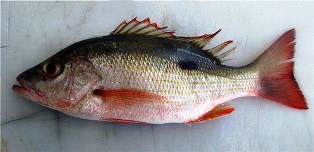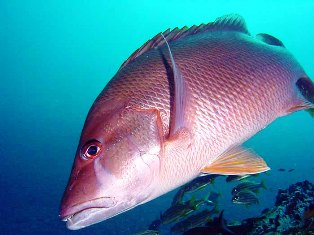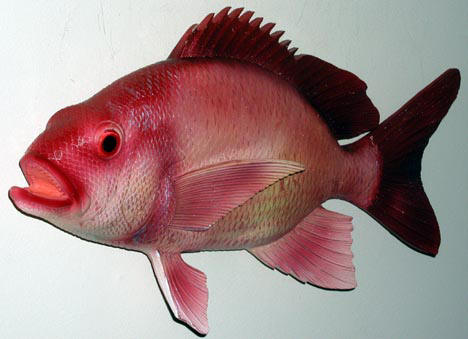Discover Florida Nature
It's time to explore the natural Florida


|
|
|
|
|
 Mahogany
Snapper (Lutjanus mahogoni)
Mahogany snapper occur from North Carolina to Venezuela,
including the Gulf of Mexico and Caribbean Sea. This species is common
in the Caribbean but is rare in US waters. The mahogany snapper occurs
in nearshore water as deep as 328 feet. It is usually found in clear,
shallow water over rocky bottoms near coral reefs but occurs less
frequently in sandy areas or seagrass. It often forms large aggregations
during the day and has been observed to school with white grunt at Grand
Cayman. This snapper has a relatively deep body. The belly runs straight
from the mouth to the anal fin. It has a pointed snout and large eyes.
The lower jaw projects beyond upper jaw. The anal fin is rounded, more
than usual in snappers. It has a bi-lobed dorsal fin and long pectoral
fin, as found in other many lutjanid fish. The anal fin is rounded. The
caudal fin is moderately forked. Mahogany snappers are very colorful
fish. Their back and upper sides are gray to dark olive, becoming
silvery on the lower sides and belly. There may be a red tinge
throughout the entire body. The mahogany snapper has an average length
of 15 inches, with a maximum length of 19 inches. The mahogany snapper
feeds nocturnally on small bottom fishes such as grunts. It also feeds
on marine invertebrates including shrimp, cephalopods, and crabs. Mahogany
Snapper (Lutjanus mahogoni)
Mahogany snapper occur from North Carolina to Venezuela,
including the Gulf of Mexico and Caribbean Sea. This species is common
in the Caribbean but is rare in US waters. The mahogany snapper occurs
in nearshore water as deep as 328 feet. It is usually found in clear,
shallow water over rocky bottoms near coral reefs but occurs less
frequently in sandy areas or seagrass. It often forms large aggregations
during the day and has been observed to school with white grunt at Grand
Cayman. This snapper has a relatively deep body. The belly runs straight
from the mouth to the anal fin. It has a pointed snout and large eyes.
The lower jaw projects beyond upper jaw. The anal fin is rounded, more
than usual in snappers. It has a bi-lobed dorsal fin and long pectoral
fin, as found in other many lutjanid fish. The anal fin is rounded. The
caudal fin is moderately forked. Mahogany snappers are very colorful
fish. Their back and upper sides are gray to dark olive, becoming
silvery on the lower sides and belly. There may be a red tinge
throughout the entire body. The mahogany snapper has an average length
of 15 inches, with a maximum length of 19 inches. The mahogany snapper
feeds nocturnally on small bottom fishes such as grunts. It also feeds
on marine invertebrates including shrimp, cephalopods, and crabs.  Mutton
Snapper
(Lutjanus analis ) The mutton snapper is found in the
western Atlantic Ocean from Massachusetts to Brazil, but is most common
in the tropical waters of Florida, the Bahamas, and the Caribbean Sea.
It is also found in the Gulf of Mexico. Large adults are found in or
near offshore reef and rock rubble habitats, while the juveniles live in
inshore areas. The juveniles are abundant in shallow waters such as
tidal mangrove creeks, canals, and shallow protected bays, utilizing
turtle grass as bottom cover. Solitary adults can be found among rocks
and reefs, while juveniles occur over sandy or sea grass bottoms. Once
an adult mutton snapper becomes established in an area, they tend to
remain there. Small aggregations of mutton snapper may form during the
day, disbanding at night. These fish may be found at depths ranging from
80 - 310 feet. This snapper is a relatively deep-bodied fish, with an
almost lunate-shaped tail. It has a moderately bi-lobed dorsal fin, and
a sharply pointed anal fin. The pectoral fin of this snapper is long,
reaching just past the anal origin. Mutton snappers are very colorful,
with olive green on their backs and upper sides and a red tinge on the
lower sides and undersides. There is a distinct black spot on the upper
back and blue stripes on the cheek region below the eye. There are two
color phases, barred which is seen when the fish is resting and plain
color seen when the fish is swimming. The mutton snapper has an average
length of 20 inches, with a maximum length of 32 inches. Mutton
Snapper
(Lutjanus analis ) The mutton snapper is found in the
western Atlantic Ocean from Massachusetts to Brazil, but is most common
in the tropical waters of Florida, the Bahamas, and the Caribbean Sea.
It is also found in the Gulf of Mexico. Large adults are found in or
near offshore reef and rock rubble habitats, while the juveniles live in
inshore areas. The juveniles are abundant in shallow waters such as
tidal mangrove creeks, canals, and shallow protected bays, utilizing
turtle grass as bottom cover. Solitary adults can be found among rocks
and reefs, while juveniles occur over sandy or sea grass bottoms. Once
an adult mutton snapper becomes established in an area, they tend to
remain there. Small aggregations of mutton snapper may form during the
day, disbanding at night. These fish may be found at depths ranging from
80 - 310 feet. This snapper is a relatively deep-bodied fish, with an
almost lunate-shaped tail. It has a moderately bi-lobed dorsal fin, and
a sharply pointed anal fin. The pectoral fin of this snapper is long,
reaching just past the anal origin. Mutton snappers are very colorful,
with olive green on their backs and upper sides and a red tinge on the
lower sides and undersides. There is a distinct black spot on the upper
back and blue stripes on the cheek region below the eye. There are two
color phases, barred which is seen when the fish is resting and plain
color seen when the fish is swimming. The mutton snapper has an average
length of 20 inches, with a maximum length of 32 inches.
 Queen
Snapper (Etelis oculatus) The queen snapper is among
the deepest dwelling species of the snappers, and its distribution
covers the tropical western Atlantic Ocean, from North Carolina to the
eastern tip of Brazil. The queen snapper is generally found offshore
over rocky reefs of the continental shelf to a depth of 450 feet. A
smaller fish, the queen snapper is usually less than twenty inches in
length. The queen snapper is red on it's back and upper sides, with the
lower sides more silvery. The body of the queens snapper is long and
slender; and it's dorsal fin is distinctly notched, and forked. The
queen snapper has large eyes and no dark lateral spot. The queen snapper
is exploited by only a few fisheries in the Caribbean. Most often it is
only a minor part of the catch of line fisheries that focus on the whole
community of snappers. Queen
Snapper (Etelis oculatus) The queen snapper is among
the deepest dwelling species of the snappers, and its distribution
covers the tropical western Atlantic Ocean, from North Carolina to the
eastern tip of Brazil. The queen snapper is generally found offshore
over rocky reefs of the continental shelf to a depth of 450 feet. A
smaller fish, the queen snapper is usually less than twenty inches in
length. The queen snapper is red on it's back and upper sides, with the
lower sides more silvery. The body of the queens snapper is long and
slender; and it's dorsal fin is distinctly notched, and forked. The
queen snapper has large eyes and no dark lateral spot. The queen snapper
is exploited by only a few fisheries in the Caribbean. Most often it is
only a minor part of the catch of line fisheries that focus on the whole
community of snappers.  Red
Snapper (Lutjanus campechanus) The red snapper is a
reef fish found in the Gulf of Mexico and the southeastern Atlantic
coast of the United States, including Florida. The red snapper commonly
inhabits waters from 30 to 200 feet, but can be caught as deep as 300
feet or more on occasion. They stay relatively close to the bottom, and
inhabit rocky bottom, ledges, ridges, and artificial reefs, including
offshore oil rigs and shipwrecks. The red snapper's body is very similar
in shape to other snappers, all feature a sloped profile,
medium-to-large scales, a spiny dorsal fin and a laterally compressed
body. Red snappers have short, sharp, needle-like teeth, however they
lack the prominent upper canine teeth found on the mutton, dog, and
mangrove snappers. Coloration of the red snapper is light red, with more
intense pigment on the back. A red snapper attains sexual maturity at
age 2–5 and an adult snapper can live for more than 50 years. Juvenile
fish can also have a dark spot on their side which fades with age. Like
most other snappers, red snappers are gregarious and will form large
schools around wrecks and reefs. These schools are usually made up of
fish of very similar size. Juveniles occur over sandy or mud bottoms and
are often taken in shrimp trawls. Adult red snapper may live more than
20 years, and attain 35 pounds or more. The Florida record for a red
snapper catch is 46 pounds, 8 ounces! Red snapper will eat almost
anything, but prefer small fish and crustaceans. They can be caught on
live bait as well as cut bait, and will also take artificial lures, but
with less vigor. The vibrant red color of these fish comes from high
levels of carotenoid pigments, largely astaxanthin, coming from shrimp
in their natural diet. Red
Snapper (Lutjanus campechanus) The red snapper is a
reef fish found in the Gulf of Mexico and the southeastern Atlantic
coast of the United States, including Florida. The red snapper commonly
inhabits waters from 30 to 200 feet, but can be caught as deep as 300
feet or more on occasion. They stay relatively close to the bottom, and
inhabit rocky bottom, ledges, ridges, and artificial reefs, including
offshore oil rigs and shipwrecks. The red snapper's body is very similar
in shape to other snappers, all feature a sloped profile,
medium-to-large scales, a spiny dorsal fin and a laterally compressed
body. Red snappers have short, sharp, needle-like teeth, however they
lack the prominent upper canine teeth found on the mutton, dog, and
mangrove snappers. Coloration of the red snapper is light red, with more
intense pigment on the back. A red snapper attains sexual maturity at
age 2–5 and an adult snapper can live for more than 50 years. Juvenile
fish can also have a dark spot on their side which fades with age. Like
most other snappers, red snappers are gregarious and will form large
schools around wrecks and reefs. These schools are usually made up of
fish of very similar size. Juveniles occur over sandy or mud bottoms and
are often taken in shrimp trawls. Adult red snapper may live more than
20 years, and attain 35 pounds or more. The Florida record for a red
snapper catch is 46 pounds, 8 ounces! Red snapper will eat almost
anything, but prefer small fish and crustaceans. They can be caught on
live bait as well as cut bait, and will also take artificial lures, but
with less vigor. The vibrant red color of these fish comes from high
levels of carotenoid pigments, largely astaxanthin, coming from shrimp
in their natural diet. |
|
|
Advertise | Privacy Statement | Dog Encyclopedia | Video |Contact | Alaska Nature |
|